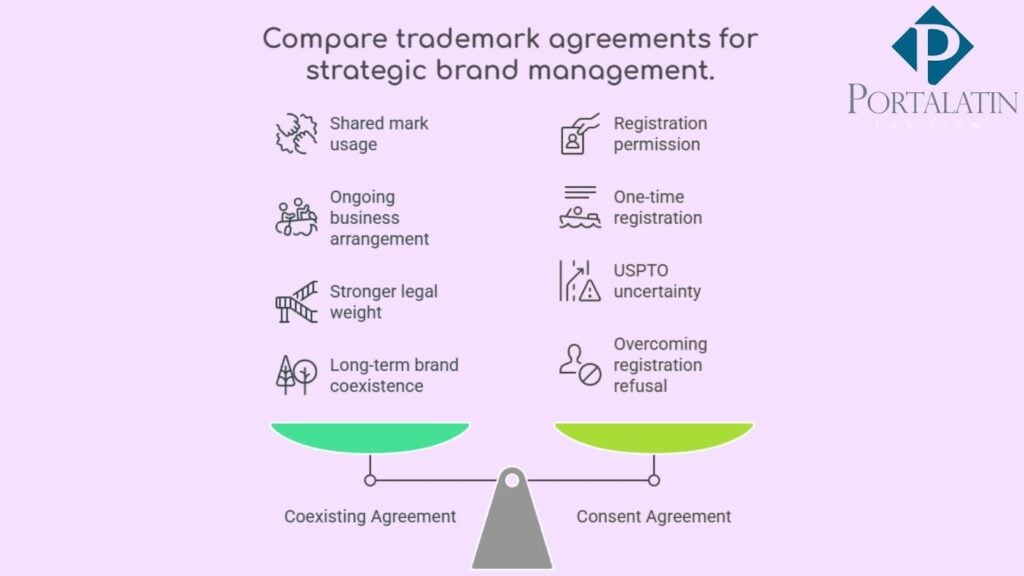Trademark coexistence agreements let two businesses use similar brands without getting into disputes. If you’re an entrepreneur or business owner, knowing how these agreements work could help you avoid legal headaches before they start.
Portalatin Business Law Firm focuses on building legal frameworks that protect your company and help you grow. We work with clients from many backgrounds, offering services in Spanish, Portuguese, and English. For entrepreneurs working internationally or just getting started, we make trademark protection clear and practical.
Key Takeaways:
- Trademark coexistence agreements allow similar trademarks to be used by different businesses, provided they operate in distinct markets or industries.
- These agreements include detailed terms covering trademark usage, geographical limits, product categories, quality standards, and enforcement protocols.
- Coexistence agreements are ideal for long-term brand separation but can pose risks if businesses later expand into overlapping markets.
- Unlike consent agreements, coexistence agreements offer broader, ongoing protection and are generally stronger in legal enforcement.
What is a Trademark Coexistence Agreement?
A trademark coexistence agreement lets two businesses use similar or even identical trademarks without fighting over rights.
With over 700,000 trademark applications filed at the USPTO in 2023 alone, there’s a growing chance that brands might bump into each other with similar names or logos. These agreements lay out where, how, and for what each company can use the trademark, so both parties avoid costly legal battles.
How Coexistence Agreements Work
The basic idea is simple: both sides agree in writing to let the other use a certain trademark, often with limits on location, product line, or industry.
For example, one business might use a mark for clothing, while another uses it for kitchenware. This written contract helps prevent confusion among customers and makes expectations clear.
Key Terms and Provisions
Most coexistence agreements cover:
- The specific trademarks allowed for use.
- Geographical areas or countries where each party can use the mark.
- The types of goods or services covered.
- Quality standards that each business must meet to protect the reputation of the trademark.
- How the agreement will be enforced and what happens if someone breaks the rules.
When Should You Use a Coexistence Agreement?
Coexistence agreements make sense when two businesses want to avoid a legal fight and can clearly separate their brands by geography, product, or customer base.
Common Business Scenarios
- Two companies with similar names operate in different industries.
- Businesses plan to expand internationally, but the same mark is already registered locally.
- Family-owned companies split but want to keep using a shared legacy brand in different markets.
When to Avoid a Coexistence Agreement
Sometimes, coexistence agreements create more problems than they solve. If there’s a high risk of confusion or if the brands might overlap in the future, a coexistence agreement might not protect you.
Risks and Drawbacks
- Agreements can be hard to enforce if business plans change.
- Future expansion could bring brands into conflict, leading to lawsuits anyway.
- Agreements aren’t always accepted by all trademark offices worldwide.
- Public confusion can still happen if brands get too close.
Coexistence vs. Consent Agreements: What’s the Difference?

Coexistence agreements and consent agreements sound similar, but they solve different problems. A consent agreement usually says one company will not object to another’s trademark application, even if the marks are similar. Coexistence agreements, on the other hand, are more detailed and lay out ongoing rights and boundaries.
Comparison Table
| Feature | Coexistence Agreement | Consent Agreement |
| Purpose | Allows both parties to use the mark | Permits registration by one party |
| Scope | Detailed, ongoing business arrangement | Often one-time, registration only |
| Legal Weight | Usually stronger, more enforceable | May not always convince USPTO |
| Use Cases | Long-term brand coexistence | Overcoming registration refusal |
Pros and Cons
Coexistence Agreements:
- Pros: Long-term, flexible, custom-made for business needs.
- Cons: Can get complicated and may require updates over time.
Consent Agreements:
- Pros: Simple, solves registration problems quickly.
- Cons: Less protection for ongoing use, may not stop future disputes.
Checklist for Creating a Strong Coexistence Agreement
Here is a checklist for brands and entrepreneurs:
- Identify all marks to be included.
- List specific goods/services and markets for each party.
- Set clear quality standards.
- Define enforcement procedures and remedies.
- Review the agreement regularly as your business grows.
- Make sure the agreement works across all relevant jurisdictions.
There aren’t published statistics on how often these agreements are drafted without lawyers, but attorneys recommend professional review for every agreement to avoid future problems.
Protect Your Brand and Plan for Growth
Trademark coexistence agreements are one of the ways you can avoid risk and keep your business moving forward.
Portalatin Business Law Firm supports entrepreneurs and companies at every stage, from building a new brand to protecting an established one. We partner with branding agencies and offer help in Spanish, Portuguese, and English, so you always have a legal team that understands your needs.
If you want to take the next step in protecting your brand, reach out through our contact page and let us help you build lasting success.




